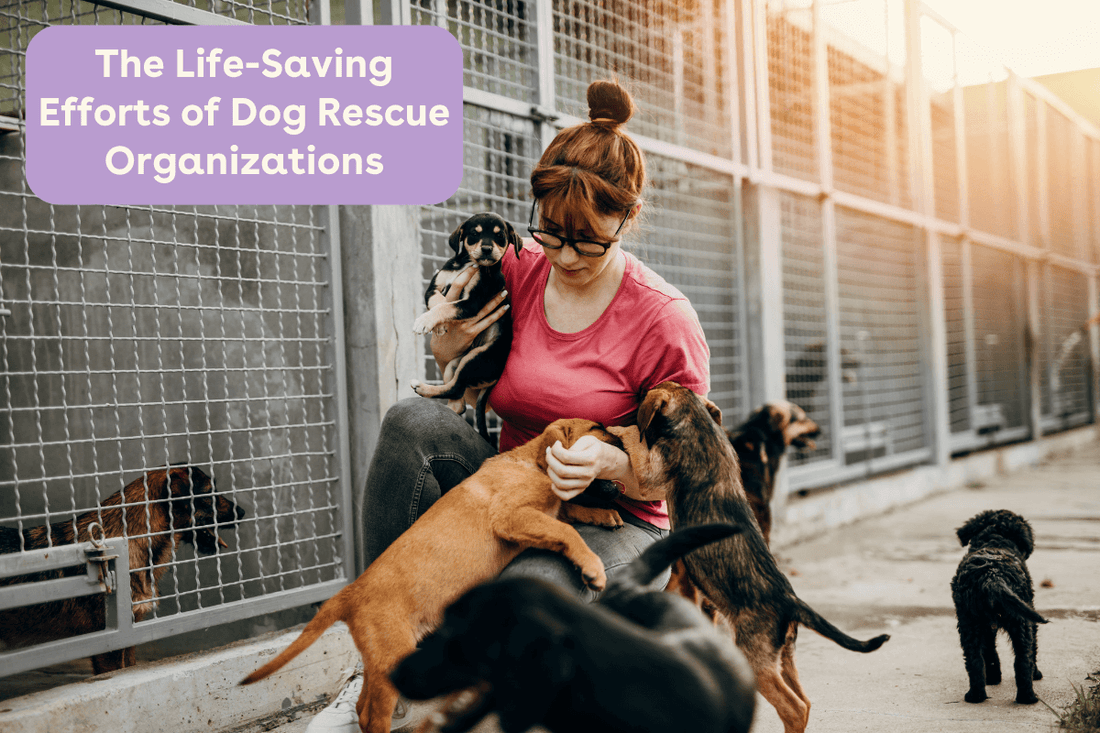Have you ever wondered what dog rescue really means? If you care about animals or have thought about giving a dog a second chance, understanding dog rescue is key.
It’s more than just saving dogs—it’s about changing lives, including yours. You’ll discover how dog rescue works, why it matters, and how you can be part of this powerful movement. Keep reading to find out how your actions can make a real difference for dogs waiting for a loving home.
Dog Rescue Basics
Understanding the basics of dog rescue is essential if you want to support or get involved in saving dogs’ lives. Dog rescue goes beyond just saving animals; it’s about providing safety, love, and a second chance. Knowing how these rescues operate helps you make informed decisions and possibly become part of this compassionate community.
Types Of Dog Rescues
Dog rescues come in various forms, each serving a specific purpose. Some focus on breed-specific rescues, helping only certain types of dogs, while others operate as general shelters taking in any dog in need.
- Breed-specific rescues:These groups specialize in saving and rehoming particular breeds, such as Bulldogs or German Shepherds.
- Local shelters:Usually run by municipalities or nonprofits, they care for stray or abandoned dogs in their area.
- Foster-based rescues:Instead of kennels, these rescues place dogs in temporary homes until adoption.
- Sanctuaries:Provide long-term care for dogs that may not be adoptable due to age or health issues.
Knowing the type of rescue helps you understand their focus and how you might contribute.
Common Rescue Scenarios
Dogs end up in rescue situations for many reasons. Some are abandoned by owners who can no longer care for them. Others are found as strays, lost without identification or homes.
There are also cases where dogs are rescued from abusive or neglectful environments. Emergency situations like natural disasters can lead to sudden rescue operations to save displaced animals.
Have you ever wondered what happens to a dog after being found on the street? Rescue groups assess their health, behavior, and needs before finding a safe place for them.
Key Players In Rescue Efforts
Rescuing dogs involves a team of dedicated people and organizations. Volunteers often play a huge role, providing care, transport, and socialization for the dogs.
Veterinarians are crucial, offering medical treatment and vaccinations to ensure dogs are healthy before adoption. Rescue coordinators manage the process, from intake to placement.
Adopters themselves are key players—you become part of the rescue story by offering a loving home. How might you contribute to your local dog rescue community today?
How Rescues Save Lives
Dog rescues play a vital role in saving lives. They provide safety, care, and hope to dogs in need. Many dogs face dangers like abuse, neglect, or abandonment. Rescues step in to protect these animals and give them a second chance. Their work covers several important areas, each focused on improving a dog’s life and future.
Rescue Operations And Techniques
Rescue teams find dogs in dangerous or harmful situations. They use tools and skills to safely capture and remove dogs from harm. Sometimes, rescues work with local shelters or law enforcement. They also respond to emergencies like natural disasters or hoarding cases. The goal is to bring dogs to safety quickly and gently.
Medical Care And Rehabilitation
After rescue, dogs often need medical attention. They receive exams, vaccinations, and treatment for injuries or illnesses. Some dogs require surgery or special care for long-term health issues. Rehabilitation helps dogs recover both physically and emotionally. Trained staff and volunteers provide love, patience, and training to rebuild trust.
Finding Forever Homes
The final step is matching dogs with loving families. Rescues carefully screen adopters to ensure a good fit. They provide support and guidance during the adoption process. Many rescues also offer foster care programs before adoption. This step gives dogs a stable and happy life they deserve.
Becoming A Rescue Volunteer
Becoming a rescue volunteer opens a rewarding path to directly help dogs in need. It’s more than just lending a hand; it’s about being a voice for those who cannot speak for themselves. If you’ve ever wondered how you can make a real difference, volunteering might be the answer.
Volunteer Roles And Responsibilities
Volunteering in dog rescue involves various roles depending on your skills and availability. You might walk dogs, help with feeding and grooming, or assist in adoption events. Administrative tasks like managing social media or coordinating foster homes are also vital.
Each role requires commitment and compassion. You’ll often be the first human contact for scared or abandoned dogs, so patience and kindness are key. How would you handle the challenge of calming a frightened dog while making it feel safe?
Training And Skills Needed
Most rescue organizations provide training to prepare you for the realities of the work. You’ll learn about dog behavior, basic medical care, and safety protocols. This training ensures you can support the dogs effectively and protect yourself.
Skills like clear communication, teamwork, and problem-solving are essential. For example, recognizing signs of stress in a dog can prevent accidents. What skills do you already have that could help in a rescue environment?
Impact Of Volunteer Work
Your efforts directly change lives, both canine and human. Rescued dogs get a second chance at happiness, and you become part of their recovery journey. Many volunteers share stories of dogs that transformed thanks to their care, highlighting the powerful bond formed.
Volunteering also builds community and personal growth. You gain new friends who share your passion and develop empathy and resilience. How might your life change by giving your time to these dogs?

Credit: pupford.com
Starting A Rescue Organization
Starting a dog rescue organization is both exciting and challenging. It requires more than just a love for animals—you need a clear plan and strong foundations to make a real impact. If you’re ready to turn your passion into action, understanding the key building blocks will help you avoid common pitfalls and set your rescue up for success.
Legal And Financial Foundations
Before rescuing any dogs, get your legal paperwork in order. Register your organization as a nonprofit or charity to qualify for tax exemptions and grants. You’ll also need to understand local animal welfare laws and licensing requirements to operate without issues.
Setting up a separate bank account for your rescue finances keeps everything transparent. Track donations, expenses, and vet bills carefully. Financial clarity builds trust with donors and volunteers, which you’ll rely on heavily.
Building A Rescue Network
Your rescue can’t function alone. Connect with local veterinarians, shelters, and foster families who share your mission. These relationships help you find dogs in need and ensure they get proper care quickly.
Don’t underestimate the power of volunteers. They bring energy, skills, and time that are priceless. Think about creating a volunteer program with clear roles and training to keep everyone motivated and effective.
Fundraising And Awareness
Money keeps your rescue running, but raising it takes creativity. Host events, start online campaigns, and reach out to your community for support. Sharing real stories and photos of dogs you’ve helped creates an emotional connection that encourages donations.
Consider social media your best friend for spreading awareness. Regular updates, success stories, and behind-the-scenes glimpses turn followers into advocates. What’s one unique way you could tell your rescue’s story that would inspire people to act?
Challenges In Dog Rescue
Dog rescue efforts face many tough challenges. These difficulties affect the ability to save and care for dogs in need. Understanding these challenges helps support rescue groups and improve dog welfare.
Overpopulation And Shelter Overflow
Too many dogs end up in shelters every day. Shelters often have more dogs than space. Overcrowding makes it hard to provide good care. Some dogs stay longer, waiting for homes. This creates stress for both dogs and workers.
Funding And Resource Limitations
Money is always tight for dog rescues. Limited funds restrict food, medicine, and shelter supplies. Many rescues rely on donations and volunteers. Lack of resources slows down rescue work. It also limits the ability to help more dogs.
Emotional And Physical Demands
Rescuing dogs is emotionally draining. Workers see many sad and sick animals. It can cause stress and burnout. Physical tasks like cleaning and lifting are tough. Rescuers must stay strong to keep helping dogs.
How To Support Dog Rescue
Supporting dog rescue goes beyond just loving animals—it’s about making choices that directly impact their lives. Whether you have space in your home or resources to share, your actions can help save dogs from uncertain futures. Here’s how you can get involved in meaningful ways that make a real difference.
Adoption Vs. Buying
Choosing to adopt a dog instead of buying one gives a homeless animal a second chance at life. Adoption often means rescuing dogs from shelters or rescue groups where they wait for someone like you. Buying from breeders or pet stores may support puppy mills, which often have poor conditions.
When you adopt, you also save money on initial veterinary costs, since many rescue organizations provide vaccinations and spaying/neutering. Have you ever thought about how many dogs could find loving homes if more people chose adoption?
Fostering Dogs
Fostering offers temporary homes to dogs in need, helping shelters reduce overcrowding. It’s a hands-on way to support dog rescue even if you’re not ready for a permanent pet. Fosters provide socialization and care, making dogs more adoptable.
Imagine giving a shy dog a safe space to build confidence before meeting their forever family. Your time and patience can transform a scared animal into a happy companion.
Donations And Advocacy
Not everyone can adopt or foster, but donations fuel rescue efforts. Money helps pay for medical care, food, and shelter improvements. You can also donate supplies like blankets, toys, or food.
Advocacy spreads awareness and encourages others to support rescue causes. Sharing stories or volunteering at events builds a community that values animal welfare. What small step can you take today to be a voice for dogs who can’t speak for themselves?
Success Stories And Impact
Success stories in dog rescue show real change and hope. They highlight the difference rescue efforts make for dogs and people. Each story reflects courage, care, and a fresh start. These stories inspire many to support and join rescue work.
Life-changing Rescues
Every rescued dog has a unique story. Some come from neglect or danger. Rescuers save them from harm and provide medical care. Many dogs find loving homes after rescue. These changes improve their health and happiness. Life-changing rescues show the power of kindness.
Community Transformations
Dog rescue strengthens communities in many ways. It reduces stray dog populations and related problems. Rescue groups bring people together to help animals. Communities gain pride in caring for their pets. Education about pet care grows through these efforts. The result is safer, healthier neighborhoods.
Long-term Benefits For Dogs And People
Rescued dogs often become loyal, loving companions. They bring joy and comfort to families. People learn responsibility and compassion through pet care. Rescue work promotes animal welfare and kindness values. These benefits last a lifetime for both dogs and humans.

Credit: www.youtube.com

Credit: www.baladidogrescue.com
Frequently Asked Questions
What Is Dog Rescue And Its Main Purpose?
Dog rescue involves saving abandoned, abused, or stray dogs. Its main purpose is to provide care and find loving homes.
How Do Dog Rescue Organizations Operate?
Dog rescue groups save dogs, provide medical care, and promote adoption. They rely on volunteers and donations for support.
Why Should I Adopt From A Dog Rescue?
Adopting from rescue saves lives, reduces shelter overcrowding, and gives dogs a second chance at happiness.
What Types Of Dogs Are Found In Rescues?
Rescues have mixed breeds, purebreds, puppies, seniors, and special needs dogs needing care and homes.
Conclusion
Dog rescue plays a vital role in society. These organizations provide a lifeline. They offer shelter, care, and hope for abandoned dogs. Volunteers and staff work tirelessly. Their dedication transforms lives every day. Adopting a rescue dog can be rewarding.
It brings joy and companionship to families. Supporting dog rescue efforts makes a difference. Every little action counts in saving lives. Consider donating or volunteering. Spread awareness about the importance of rescue. Together, we can create a loving future for all dogs.

Emily Barker is the founder of ChillDogLife.com, a space dedicated to helping pup parents discover the best dog products, lifestyle tips, and cozy ideas for happier homes.
A lifelong dog lover, Emily combines her passion for pets with a knack for research to share trusted recommendations on everything from toys and furniture to health and everyday care.
Her goal is simple: to make life easier, stylish, and more joyful for dogs and the people who love them.







